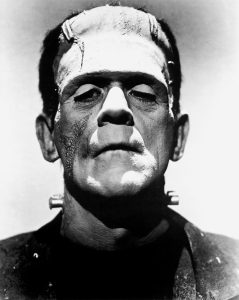F R A N K E N S T E I N
This past weekend I read Frankenstein by Mary Shelley. Written in 1818, this book is considered to be one of the first science fiction texts. This story is an interesting cross between my study of Science Fiction in this course and my study of English romantic era authors, a cohort of writers and thinkers with which Shelley was entangled. It was a lot of fun to think about and read this text through both of these lenses – there were so many elements that are reflective of romantic era concerns: psychology, love, loneliness, humanity, ethics, morality, nature and our relationship to it, religion and the role of God and the supernatural… At the same time, these are concerns that are central in SF texts today.
In its time, Frankenstein was a daring tale – what it suggested, explored, and described was shocking, especially when it considering it came from the mind of a woman (initially it was published anonymously however). Comparing to SF today, its SF elements are quite tame. But, perhaps that’s what makes it most disturbing and provoking. The un-named monster that Frankenstein creates is very human-like in look and behavior. He has the potential to fold into the human race – overlooking his ugliness of course. His desires, emotions, mind are really that of a human. It is his lack of connection, his loneliness and rejection from humans that creates a monster out of him. I can really identify with his frustration and destructive reaction to his pain. I sympathized with the psychology of the monster, even though he was violent and murderous.
I was particularly irritated by Viktor Frankenstein, the creator of the monster. He was ambitious and selfish in pursuing such an invention. Once successful, he was horrified by what he had created. He flees his laboratory and avoids it for several years. I would honestly say that 60% of the book is made up of Viktor’s lamentations, expressions of disgust, pity, and despondency. It is relentless and kind of irritating – you just want to shake him and tell him to take responsibility! It is clear that the monster is actually good-natured, polite, and has no desire to hurt anyone. This is made clear to Frankenstein, but he cannot get over the monster’s appearance and the fact that he had created him. I think the central lesson of the book is here, in the behavior of Frankenstein. This is communicated well in an article I found in Nature:
“So emerges the central drama of the novel. It is not merely the creation of life itself, the technical ambition of science, that is called into question. It is the unfolding moral choices and unforeseen ethical responsibilities that may come with scientific advances: artificial intelligence or artificial life, nuclear power or nuclear weaponry, the genome sequence or invasive genetic editing.”
Frankenstein was written over 200 years ago, but its warning about the moral responsibility we have to the things we create and the ideas we spread. There must be forethought about how the thing itself, others, and ourselves will be effected by what we pursue and create, and we must take responsibility for what is produced.

Mary Shelley

An interpretation of the monster created by Frankenstein from the 1932 film. (Which is hilarious!)
